The Corsair RM1000x and RM1000i 1000W Power Supply Review
by E. Fylladitakis on September 30, 2015 8:00 AM EST- Posted in
- Cases/Cooling/PSUs
- Corsair
- RM Series
- Corsair Link
The Corsair RM1000i & RM1000x PSU - External Appearance
Physically, the RM1000i and RM1000x are nearly identical to each other. Their chassis is sprayed with a matte black color that is well applied and fingerprint-resistant. Further aesthetic improvements include chamfered side edges and side stickers with the model's number printed on them.
Another sticker can be found at the top of the chassis, with the electrical specifications of the unit. Both models are using the same 180mm long chassis. Note that this chassis is significantly longer than a standard ATX design (140mm) and may not fit into some designs, especially very compact layouts.
The front of the PSUs are littered with the numerous connectors for the modular cables. The number and type of connectors is identical, with the sole exception that the RM1000x lacks the Corsair Link interface connectors and the test button. There is a very basic legend printed beneath each group of connectors. Both the PCI-Express and the CPU 12V cables use the same connectors, the 6-pin connectors are for the SATA/Molex cables and the split 10+18 connector is for the 24-pin ATX cable.
The Corsair RM1000i & RM1000x PSU - Internal Design
The 135mm fan responsible for the cooling of the RM1000i and the RM1000x is a Corsair NR135P fan. As even the UL certification number points back to Corsair, this technically is Corsair's own unique product and not a re-branded fan, though it's a safe bet that ultimately some hereto-unknown Chinese factory still makes it for them. It has a FDB bearing and a maximum speed of about 1500 RPM. At this point we should note that both of the units feature a "zero-RPM fan mode", meaning that the fan will not start before the load is significant and component temperatures will require active cooling.
Both the RM1000i and the RM1000x are virtually identical on the inside as well, with the mere difference being the RM1000x lacking the circuitry related to the Corsair Link interface. The OEM behind their creation is Channel Well Technologies (CWT) and both units actually are an upgrade of the design that the RM1000 was based upon.
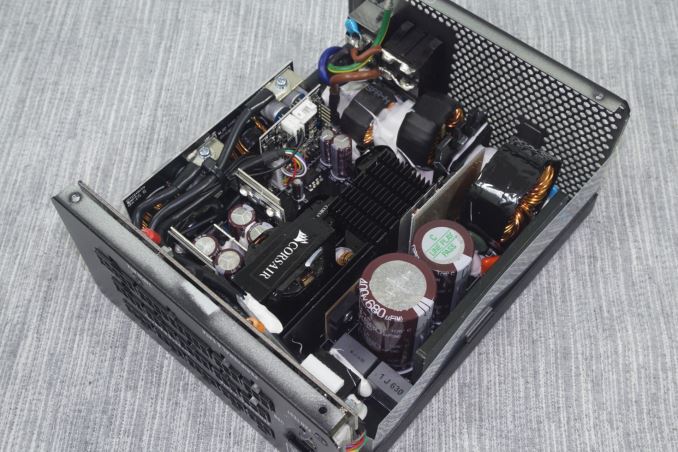
RM1000i (left) & RM1000x (right)
The first notable upgrade is the heatsinks. The heatsinks of the RM1000 were preposterously small for a PSU with that kind of output and rightfully Corsair thought that they would be a good place to start upgrading. Most of their focus was placed on the heatsink cooling the transistors at the primary side of the transformer, which is a huge upgrade over the small solid block of metal we saw in the original RM1000. The heatsink holding the APFC diode and transistors is still a solid block but it is a little longer.
The second upgrade is the sizing and the quality of the components. At the primary side, the APFC capacitors are still supplied by Nippon Chemi-Con but they are one 680μF and one 470μF capacitor, for a whopping total capacitance of 1150μF. The original RM1000 had two 390μF capacitors instead. Note that the capacitors of the RM1000i and the RM1000x may look physically different, but they actually are identical (KMR vs KMW series). Only their physical proportions differ and Corsair may be using either model depending on their availability. All of the secondary side capacitors, electrolytic and polymer alike, are now supplied by Nippon Chemi-Con as well, not TAICON and CapXon.
There are no sizable heatsinks at the secondary side of the transformer. The rectifying MOSFETs are being cooled by small metallic bars, some of which are being used as current distribution bars as well. Corsair is also using a lot of silicon glue throughout the unit, in an effort to enhance its mechanical cohesion. They seem to have placed a particular amount of effort to minimize electromagnetic vibration noise, or "coil whine", by placing a lot of glue on every inductor of the unit. They even wrapped the larger inductors with insulating material.
This vertical PCB is the only part that is notably different between the two units. Where the RM1000i has a microcontroller, the RM1000x is plain and shorted to follow only a core, pre-programmed thermal control set of instructions. The RM1000i's stock fan profile is identical but can be adjusted via the Corsair Link interface.


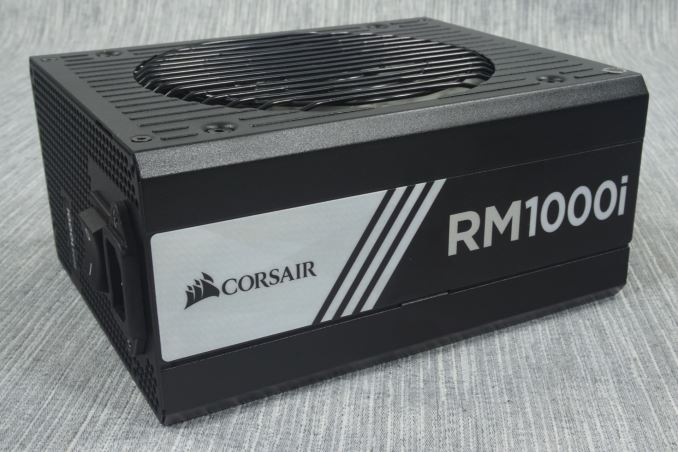
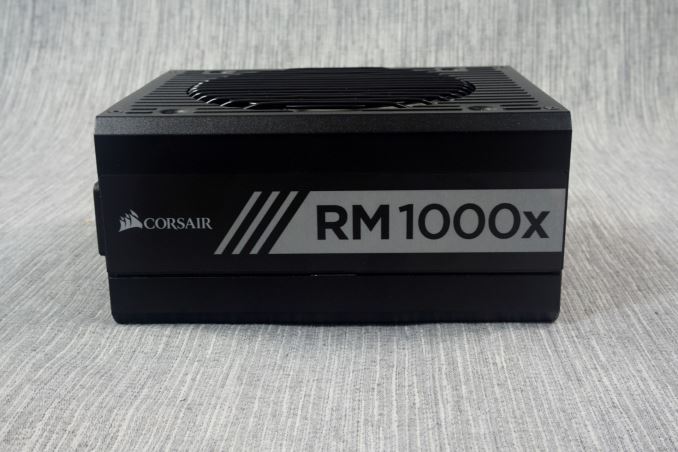
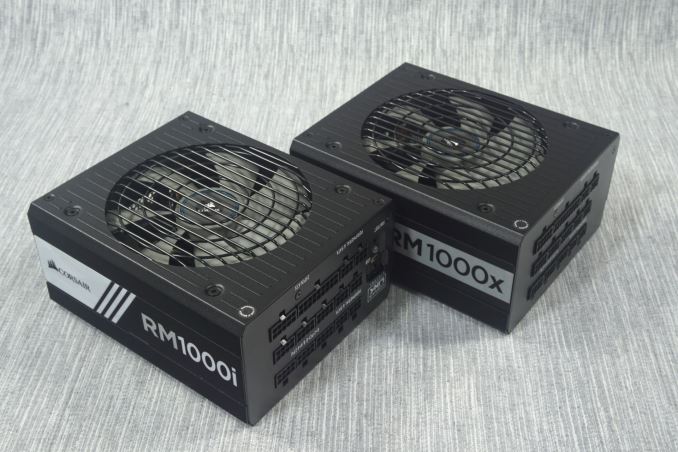
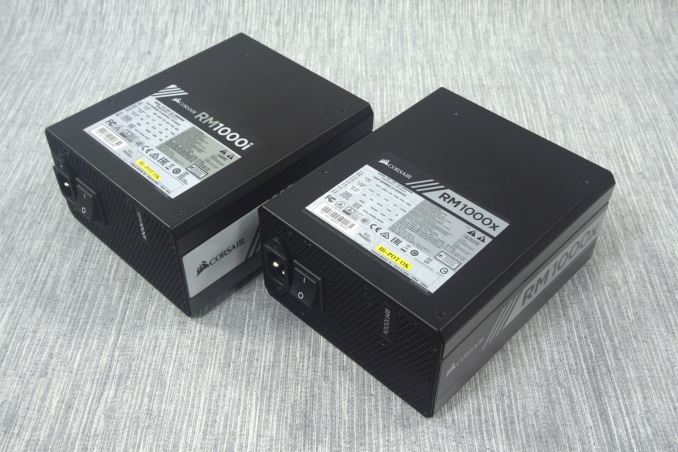
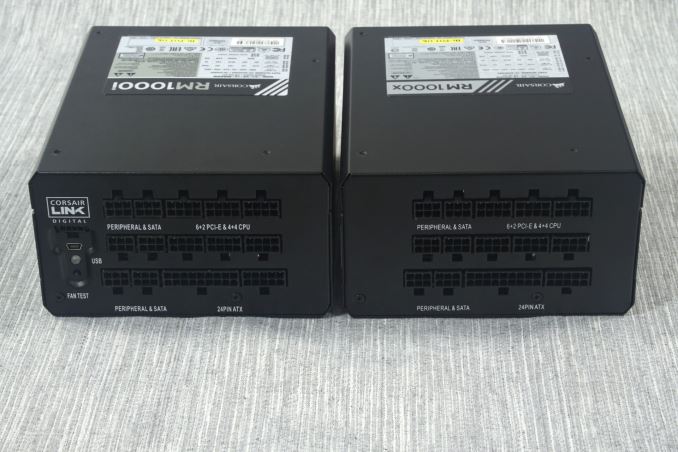
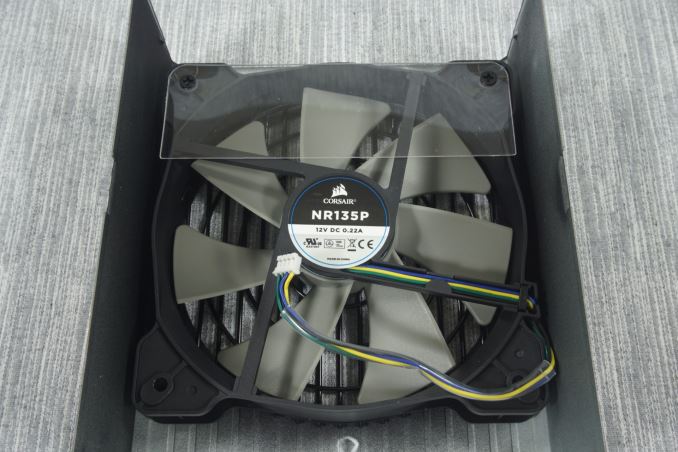
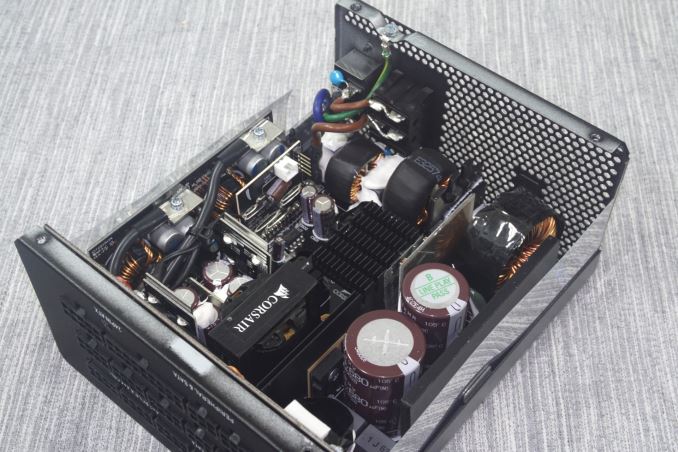












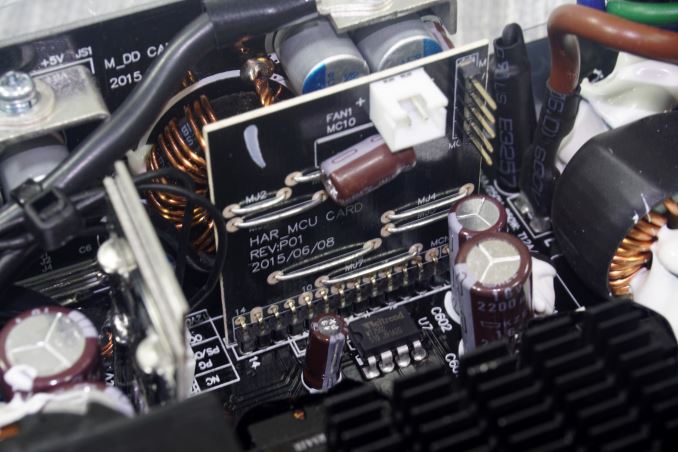








47 Comments
View All Comments
HOOfan 1 - Wednesday, September 30, 2015 - link
Looks like you may have been getting 80 Plus Platinum efficiency from itHOOfan 1 - Wednesday, September 30, 2015 - link
Nevermind, I see you were using a 230V input, but it still exceeded 80 Plus Gold by a decent amountBearmann - Wednesday, September 30, 2015 - link
Excellent review! Noted a couple of typo's in the board layout discussion. Regarding the capacitors, I think you meant "whopping". I'm sure you meant to say "coil whine" within the quotes.E.Fyll - Wednesday, September 30, 2015 - link
Thank you Bearmann. The spellchecker/auto-correct are not as smart as they should be sometimes. :)Cow86 - Wednesday, September 30, 2015 - link
There is another difference between the RMi and RMx series that the author is apparently unaware of: The RMi series uses a Fluid Dynamic Bearing fan, whilst the RMx series uses a Rifle Bearing fan, same as the RM series. The latter is supposed to not last as long, and also potentially be a little noisier. The difference is marginal though, so I think it's still very much justified to buy the RMx series if you don't need the Corsair Link. I'll definitely be looking at it for my next build :)E.Fyll - Wednesday, September 30, 2015 - link
Although the "reviewer's guide" that I received says so as well, both of the units that I received had an NR135P fan installed. Perhaps the fan of the lower wattage models is different or Corsair ran out of NR135L's while making our samples. :)Cow86 - Wednesday, September 30, 2015 - link
Seems strange, as the FDB fan would be superior normally, so if they're saying it has it, and it then doesn't, that seems like false advertising even to me. I mean, it's not huge, but getting a different (and potentially inferior) fan to what you're supposed to be getting is not cool. Maybe all the production models have the FDB fan (the NR135L I guess) though in the RMi series...I'd hope so.Oxford Guy - Wednesday, September 30, 2015 - link
Actually it is huge. FDB fans should never be advertised and then switched out for crappier fans. Ever.Cow86 - Wednesday, September 30, 2015 - link
You're right, and having thought about it a little more I feel more strongly about it now too. This is false advertising if these are making it to customers like this. You're paying a premium for Corsair Link AND the longer lasting FDB fan, so it should damn well have it. @E.Fyll: Any chance of a follow-up with Corsair on that?jonnyGURU - Wednesday, September 30, 2015 - link
The RMi shouldn't have had a rifle bearing fan. Let me see what happened there.